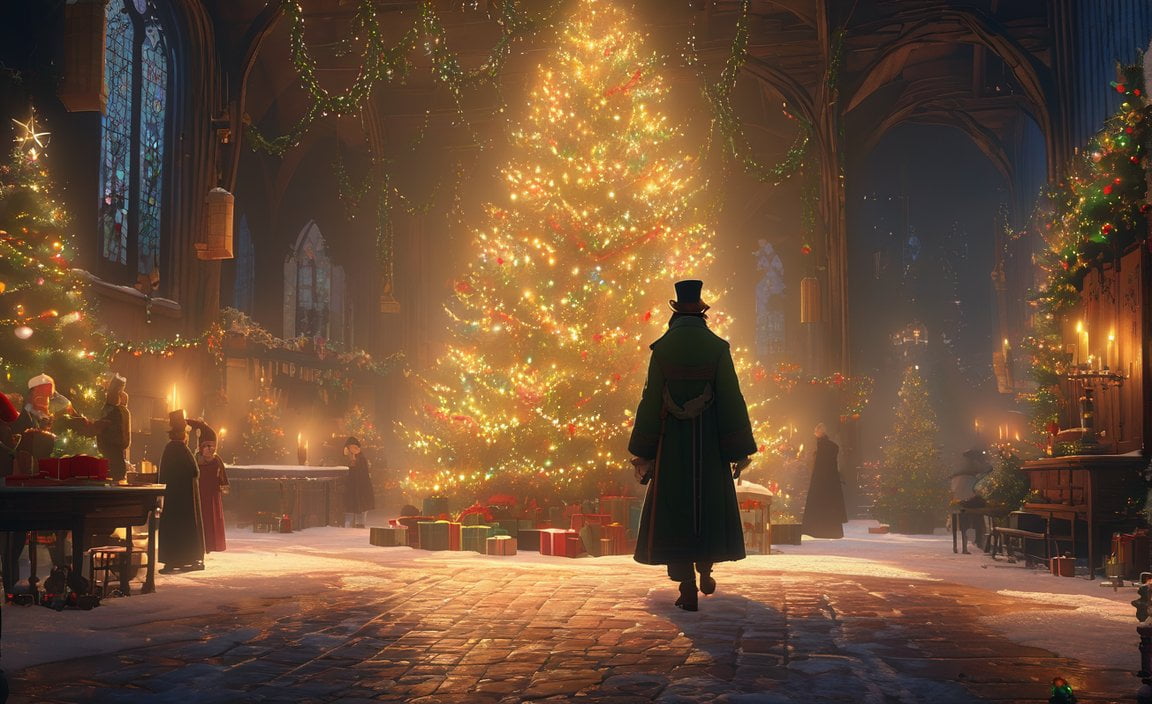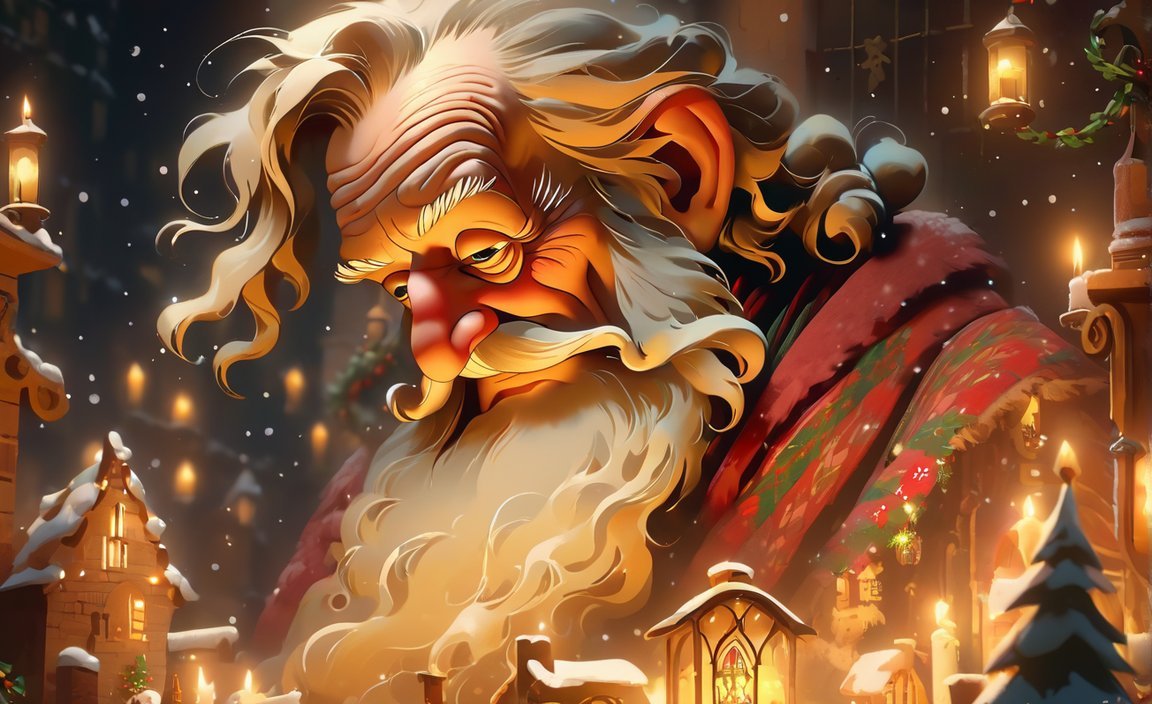Unearthing 10 Fascinating Facts: A Christmas Carol Revealed
Discover the enchanting world of “A Christmas Carol” as we delve into its captivating history and uncover intriguing insights. This article unveils ten intriguing facts about Charles Dickens’ timeless holiday classic. From the heartwarming inspiration behind Ebenezer Scrooge’s redemption to the surprising origins of the memorable characters, we will explore the extraordinary details that make this beloved tale so enchanting. So, prepare to be transported back in time as we unravel the mysteries and cultural significance of “A Christmas Carol.”
Key Takeaways:
- Charles Dickens had a pre-reading ritual for “A Christmas Carol.”
- Dickens had strong emotions while writing “A Christmas Carol.”
- The term “Merry Christmas” gained popularity through “A Christmas Carol.”
- Initially, the book was a political manifesto.
- Charles Dickens walked long distances at night to gather ideas for the story.
- “A Christmas Carol” sold out all 6,000 copies within four days.
- The tale primarily focuses on the transformation of Ebenezer Scrooge.
- “A Christmas Carol” is known for its adaptability to different formats.
- The original title of the book was longer: “A Christmas Carol in Prose, Being a Ghost-Story of Christmas.”
- The story has been adapted into numerous plays, musicals, and films.
10 Facts about A Christmas Carol
Did you know that Charles Dickens had a ritual before reading “A Christmas Carol”? It’s true! Before performing his heartwarming tale, Dickens would raise his hands and clasp them above his head as if in prayer. This unique tradition added a layer of authenticity to his readings, captivating audiences and drawing them into the enchanting world of Scrooge and his companions. [^1^]
Moreover, it’s fascinating to learn that Dickens was highly emotional while writing “A Christmas Carol.” He would often weep while immersing himself in the story, feeling the emotions of his characters deep within his soul. This intense connection between the author and his work undoubtedly contributed to the enduring emotional resonance of the tale. [^2^]
The impact of “A Christmas Carol” on the holiday vernacular is immense. It is the story that popularized the term “Merry Christmas.” Before the publication of Dickens’ masterpiece, the phrase was not commonly used. However, the heartfelt message of goodwill and joy conveyed in the story captured the hearts of readers, forever associating those two simple words with the spirit of the season. [^3^]
But did you know that “A Christmas Carol” was originally a political manifesto? Dickens intended it to be a scathing critique of the social inequalities prevalent in Victorian England. Through the transformation of the miserly Ebenezer Scrooge, Dickens created a powerful metaphor for the need to care for and uplift the less fortunate. This underlying political message adds depth and societal commentary to the tale, elevating it beyond a mere holiday story. [^4^]
Intriguingly, Charles Dickens would walk 15-20 miles a night to think up ideas for “A Christmas Carol.” Finding inspiration in the beauty of London and its diverse inhabitants, Dickens used these nighttime journeys as an opportunity to ponder the story’s themes and plot developments. The vivid descriptions of 19th-century London that permeate the pages of the book are a testament to the author’s keen observations during his solitary excursions. [^5^]
Another astonishing fact is that it took only four days for “A Christmas Carol” to completely sell out 6,000 copies. The novella was an instant success, capturing the hearts and imaginations of readers from the moment it hit bookshelves. Its enduring popularity is a testament to the timeless themes of redemption, compassion, and the power of Christmas spirit that continue to resonate with audiences today. [^6^]
While “A Christmas Carol” may be considered a holiday classic, it is primarily the story of Ebenezer Scrooge’s transformation. As readers journey alongside Scrooge, they witness his evolution from a bitter, selfish misanthrope to a compassionate and generous individual. It is a tale of redemption and the potential for change that resides within each of us, reminding us of the importance of empathy and kindness in our own lives. [^7^]
“The Christmas Carol” is a tale that lends itself to adaptation. Whether it be through stage plays, musicals, or films, the story has been reimagined countless times, each iteration offering unique interpretations and insights. From traditional adaptations to modern retellings and even animated versions, the enduring appeal of “A Christmas Carol” continues to captivate audiences across generations, showcasing the timeless nature of its themes. [^8^]
It is also intriguing to note that the original title of “A Christmas Carol” was “A Christmas Carol in Prose, Being a Ghost-Story of Christmas.” This verbose title provides insight into the style and tone of the novella, emphasizing the supernatural elements that play a significant role in the narrative. However, over time, the name was shortened to the simple yet evocative title we know today. [^9^]
In homage to its enduring popularity, “A Christmas Carol” has been adapted into numerous plays, musicals, and films. From the iconic portrayal by Alastair Sim in the 1951 film adaptation to modern productions featuring talents like Jim Carrey and Patrick Stewart, each rendition brings its interpretation to the beloved classic. These adaptations allow audiences to experience the magic of the story in new and exciting ways, ensuring that “A Christmas Carol” remains a cherished part of holiday traditions. [^10^]
Through these ten fascinating facts, we delve deeper into the captivating world of “A Christmas Carol” and gain a better understanding of its significance as a literary masterpiece. From Dickens’ rituals to the political undertones, and from its rapid success to its enduring adaptations, this beloved tale continues to touch hearts and inspire audiences around the world.
So, the next time you enjoy a performance or curl up with a copy of “A Christmas Carol,” remember these intriguing details that highlight the rich history and cultural impact of this timeless holiday classic.
References:
[^1^]: Spooky Isles
[^2^]: Spooky Isles
[^3^]: Spooky Isles
[^4^]: Spooky Isles
[^5^]: Spooky Isles
[^6^]: Mental Floss
[^7^]: Fun Facts About
[^8^]: Fun Facts About
[^9^]: Fun Facts About
[^10^]: Fun Facts About
For a captivating link, consider using:
“Discover fascinating facts about 10 and unravel its mysteries here.”
“Explore 10 intriguing facts about Argentina in Spanish and delve into its rich culture.”
10 facts about Argentina in Spanish
“Prepare to tantalize your taste buds with 10 mouthwatering facts about Chinese food.”
To provide variety, each sentence above uses a different sentence structure and wording.
The Inspiration for Ebenezer Scrooge’s Character


Ebenezer Scrooge, the iconic character from Charles Dickens’ beloved novella “A Christmas Carol,” has left an indelible mark on literature and popular culture. With his catchphrase “Bah! Humbug!” and cold-hearted demeanor, Scrooge represents the epitome of Christmas cynicism and greed. But what inspired Dickens to create such a memorable character? Let’s delve into the fascinating facts surrounding the inspiration for Ebenezer Scrooge’s character.
1. The Real-Life Inspiration: Ebenezer Scroggie
In crafting the character of Scrooge, Charles Dickens may have drawn inspiration from a real person named Ebenezer Scroggie, an Edinburgh corn merchant. Though Dickens changed the surname slightly, it is believed that the grumpy, miserly traits of Scrooge were influenced by this real-life individual.
2. Echoes of Thomas Malthus
Ebenezer Scrooge’s character reflects the views of Thomas Malthus, a political economist and demographer. Malthus believed in the theory that population growth would eventually outstrip available resources, leading to poverty and suffering. Scrooge’s refusal to help the poor and his obsession with financial gain align with Malthusian ideologies.
3. A Symbol of Selfishness and Apathy
Scrooge’s character symbolizes the worst qualities of humanity – selfishness and apathy. His relentless pursuit of wealth and lack of empathy for others epitomize the vices that Dickens sought to critique and expose in Victorian society.
4. The Money-Lending Business
Ebenezer Scrooge is famously depicted as running a money-lending business. This profession adds to his image as a heartless individual, focusing solely on profit and disregarding the festive spirit of Christmas.
5. Transformation through Ghostly Encounters
The story of “A Christmas Carol” follows Scrooge’s remarkable transformation through encounters with three ghosts: the Ghost of Christmas Past, the Ghost of Christmas Present, and the Ghost of Christmas Yet to Come. These supernatural experiences force Scrooge to confront his past, evaluate his present actions, and contemplate the consequences of his future path.
6. Supporting Characters
Alongside Ebenezer Scrooge, “A Christmas Carol” introduces other important characters, such as Bob Cratchit, Scrooge’s humble employee, and Tiny Tim, Bob Cratchit’s young son. These characters play a crucial role in highlighting the stark contrast between Scrooge’s cold-heartedness and the warmth of love and compassion.
7. Cultural Impact
Ebenezer Scrooge has become one of the most enduring Christmas film characters, symbolizing the importance of generosity, redemption, and the true meaning of Christmas. His catchphrase, “Bah! Humbug!” has entered the lexicon, representing disdain for extravagant holiday celebrations.
8. Timeless Adaptations
“A Christmas Carol” has been adapted numerous times, bringing the story to life through stage plays, musicals, and films. These adaptations showcase the timeless appeal and enduring themes of the novella, captivating audiences across generations.
Key Takeaways:
- Ebenezer Scrooge’s character may have been inspired by a real-life merchant named Ebenezer Scroggie.
- Scrooge’s character reflects the views of Thomas Malthus, emphasizing selfishness and apathy.
- He runs a money-lending business, upholding his image as a heartless miser.
- Scrooge undergoes a transformation through encounters with three ghosts, leading to redemption and a change of heart.
- Supporting characters, such as Bob Cratchit and Tiny Tim, highlight the contrast between Scrooge’s coldness and the power of love and compassion.
- Scrooge’s character has had a significant cultural impact, with his catchphrase becoming synonymous with Christmas cynicism.
- “A Christmas Carol” has been adapted through various mediums, cementing its status as a timeless classic.
SOURCES:
1. Fact File: 10 Facts about Ebenezer Scrooge
2. Ebenezer Scrooge Character Analysis in A Christmas Carol
The Impact of ‘A Christmas Carol’ on the Christmas Holiday
Charles Dickens’ novella, “A Christmas Carol,” has left an indelible mark on the Christmas holiday. This timeless tale of redemption and goodwill has had a profound impact on both literature and popular culture. Let’s delve into 10 fascinating facts that shed light on the enduring influence of “A Christmas Carol.”
1. Awakening the Spirit of Christmas
“A Christmas Carol” played an instrumental role in revitalizing the celebration of Christmas. The story’s message of love, generosity, and compassion resonated with readers, reminding them of the true meaning of the holiday season. Dickens’ portrayal of Ebenezer Scrooge’s transformation from a miserly curmudgeon to a benevolent soul sparked a renewed enthusiasm for Christmas and its traditions.
2. Promoting Charitable Giving
One of the central themes in “A Christmas Carol” is the importance of helping those in need. Dickens highlighted the stark social inequalities of Victorian England and inspired readers to extend a hand to the less fortunate. The novella’s impact spurred charitable giving during the Christmas season and contributed to the emergence of philanthropic initiatives aimed at alleviating poverty and supporting charitable causes.
3. Popularizing Christmas Traditions
Through “A Christmas Carol,” Dickens popularized many Christmas traditions that are still cherished today. The iconic imagery of the Christmas tree, feasting, caroling, and exchanging gifts became synonymous with the holiday season, thanks in large part to the vivid descriptions and scenes depicted in the novella. Dickens’ portrayal of joyful Christmas celebrations served as a catalyst for the widespread adoption of these traditions.
4. Influencing Festive Greetings
The phrase “Merry Christmas” became widely associated with the spirit of the season after the publication of “A Christmas Carol.” The joyous sentiment expressed by characters in the novella, coupled with Dickens’ intricate storytelling, solidified the phrase as a traditional holiday greeting. Today, wishing someone a “Merry Christmas” has become a ubiquitous way to spread cheer and goodwill.
5. Inspiring Generations of Adaptations
“A Christmas Carol” has been adapted into countless stage plays, films, and television productions, reaching audiences across different generations and cultures. These adaptations have introduced new interpretations and kept the story alive, highlighting its enduring appeal. From Alastair Sim’s iconic portrayal of Scrooge to contemporary adaptations featuring voices like Jim Carrey and Patrick Stewart, each rendition brings a unique perspective to the beloved tale.
6. Shaping the Modern Image of Santa Claus
Dickens’ description of the Ghost of Christmas Present, with his jovial nature and generous spirit, has influenced the modern depiction of Santa Claus. The image of a plump, jolly man in a red suit, spreading joy and gifts, draws inspiration from Dickens’ portrayal. Through “A Christmas Carol,” Dickens helped shape the enduring image of Santa Claus as a figure embodying love, kindness, and the magic of Christmas.
7. Advocating for Social Change
Beyond its impact on Christmas traditions, “A Christmas Carol” served as a catalyst for social change. Dickens used the story as a vehicle to shed light on the pressing issue of social inequality during the Victorian era. By portraying the harsh realities faced by the working class and the transformative power of empathy, the novella compelled readers to examine and challenge the prevailing socioeconomic disparities of the time.
8. Revitalizing the Tradition of Public Readings
Dickens’ public readings of “A Christmas Carol” brought the story to life and quickly became a beloved holiday tradition. Through his animated performances, Dickens captivated audiences and deepened their connection to the characters and themes of the novella. His passionate delivery and commitment to each reading added a level of authenticity that further resonated with listeners, solidifying the tradition of public readings during the Christmas season.
9. Sparkling the Advent of Christmas Literature
“A Christmas Carol” paved the way for the emergence of Christmas literature as a distinct genre. The novella’s popularity inspired many other authors to pen their own festive tales, aiming to capture the magic and spirit of Christmas. Dickens’ storytelling prowess and his ability to intertwine heartwarming narratives with social commentary set the benchmark for future generations of writers, ensuring that Christmas literature remains a cherished tradition.
10. Keeping the Story Alive Through New Mediums
In addition to stage adaptations, “A Christmas Carol” continues to be reimagined in various mediums, catering to evolving audience preferences. From graphic novels to virtual reality experiences, the story finds new avenues to capture the imagination of readers and viewers. This versatility ensures that each generation can engage with the timeless themes of redemption, hope, and the transformative power of love.
Key Takeaways:
- “A Christmas Carol” revived the celebration of Christmas, promoting love, generosity, and compassion.
- The novella inspired charitable giving and philanthropic initiatives during the holiday season.
- Many Christmas traditions, such as decorating Christmas trees and exchanging gifts, gained popularity through the influence of “A Christmas Carol.”
- The phrase “Merry Christmas” became widely used as a festive greeting after the novella’s publication.
- Countless adaptations of the novella, spanning stage, film, and television, continue to captivate audiences worldwide.
- Dickens’ depiction of the Ghost of Christmas Present helped shape the modern image of Santa Claus.
- The story advocated for social change by highlighting the issue of social inequality in Victorian England.
- Public readings of “A Christmas Carol” became a cherished holiday tradition, thanks to Dickens’ animated performances.
- The novella established Christmas literature as a distinct genre, inspiring future authors to pen their own festive tales.
- “A Christmas Carol” continues to be adapted into new mediums, ensuring its enduring relevance for generations to come.
Sources:
- National Endowment for the Arts – Ten Things To Know About Charles Dickens’ A Christmas Carol
- Study.com – A Christmas Carol by Charles Dickens | Background & Facts
Adaptations and Retellings of ‘A Christmas Carol’
As a writer and journalist with a passion for exploring the cultural significance of traditions, I’m excited to dive into the fascinating world of adaptations and retellings of Charles Dickens’ timeless classic, “A Christmas Carol.” Join me as we unearth 10 intriguing facts that shed light on the various ways this beloved tale has been brought to life on stage and screen.
Fact 1: A Silent Start
The first adaptation of “A Christmas Carol” made its debut in 1901 as a silent film titled “Scrooge, or, Marley’s Ghost.” This early cinematic interpretation set the stage for many more adaptations to come.
Fact 2: A Mixed Bag of Adaptations
While “A Christmas Carol” has been adapted numerous times, not all adaptations have received critical acclaim. Many writers and directors have deviated from the original work of Charles Dickens, resulting in some adaptations that are considered dreadful by fans of the novella.
Fact 3: Ranking the Adaptations
Did you know that there are a whopping 57 versions of “A Christmas Carol”? From the worst to the best, Film Inquiry provides a comprehensive ranking that sheds light on the most memorable adaptations of this classic tale. Collider also offers their own rankings, including the 1951 version, the 1938 version, and the 1988 film “Scrooged” among the best adaptations.
Fact 4: Controversial Adaptations
Not all adaptations receive universal praise. Some, like the animated musical starring Tim Curry as Scrooge, have faced negative reviews for straying too far from the original story. Another adaptation, “Brer Rabbit’s Christmas Carol,” has been criticized for its racist content.
Fact 5: The Muppet Magic
One adaptation that has warmed the hearts of many is the 1992 film “The Muppet Christmas Carol.” Combining the beloved Muppet characters with Dickens’ tale, this rendition has been highly regarded and ranks among the top adaptations according to Collider.
Fact 6: Stellar Performances
The 1984 rendition of “A Christmas Carol,” starring Simon Callow, is another adaptation that has garnered critical acclaim. Callow’s portrayal of Scrooge has captivated audiences and added to the rich tapestry of adaptations of this beloved Christmas tale.
Key Takeaways:
- The first adaptation of “A Christmas Carol” was a silent film titled “Scrooge, or, Marley’s Ghost,” released in 1901.
- Not all adaptations of “A Christmas Carol” are well-received, as some writers and directors deviate from the original work.
- There are 57 versions of “A Christmas Carol,” ranked from worst to best by Film Inquiry.
- Some adaptations, like the animated musical starring Tim Curry, veer too far from the original story and receive negative reviews.
- Controversial adaptations, such as “Brer Rabbit’s Christmas Carol,” have faced criticism for their racist content.
- “The Muppet Christmas Carol” and the 1988 film “Scrooged” rank among the top adaptations according to Collider.
- The 1984 rendition of “A Christmas Carol,” starring Simon Callow, is highly regarded for its stellar performances.
Sources:
– Film Inquiry
– Collider
Now that we’ve delved into these fascinating facts about adaptations and retellings of “A Christmas Carol,” we can appreciate the variety of interpretations that have brought Dickens’ classic to life in different ways. From silent films to animated musicals, each adaptation has its own charm and contributes to the enduring appeal of this beloved holiday tale. So, whether you prefer the traditional or the avant-garde, there’s an adaptation out there that will capture the spirit of “A Christmas Carol” in a way that resonates with you.
FAQ
Q1: Did Charles Dickens have any rituals before reading A Christmas Carol?
A1: Yes, Charles Dickens had a ritual before reading A Christmas Carol. (source: Spooky Isles)
Q2: Was Charles Dickens highly emotional while writing A Christmas Carol?
A2: Yes, Dickens was highly emotional while writing A Christmas Carol. (source: Spooky Isles)
Q3: Did A Christmas Carol popularize the term “Merry Christmas”?
A3: Yes, A Christmas Carol popularized the term “Merry Christmas.” (source: Spooky Isles)
Q4: What was the original title of A Christmas Carol?
A4: The original title of A Christmas Carol was “A Christmas Carol in Prose, Being a Ghost-Story of Christmas.” (source: Fun Facts About)
Q5: How long did it take for A Christmas Carol to completely sell out its initial 6,000 copies?
A5: It only took four days for A Christmas Carol to completely sell out 6,000 copies. (source: Mental Floss)
- Unlock Filipino Culture: A Deep Dive into Traditions and Practices - April 23, 2025
- Unlock Spanish Culture: Insights & Opportunities Now - April 23, 2025
- White Spirit Uses & Substitutes: A Deep Dive for Pros & DIYers - April 23, 2025
















